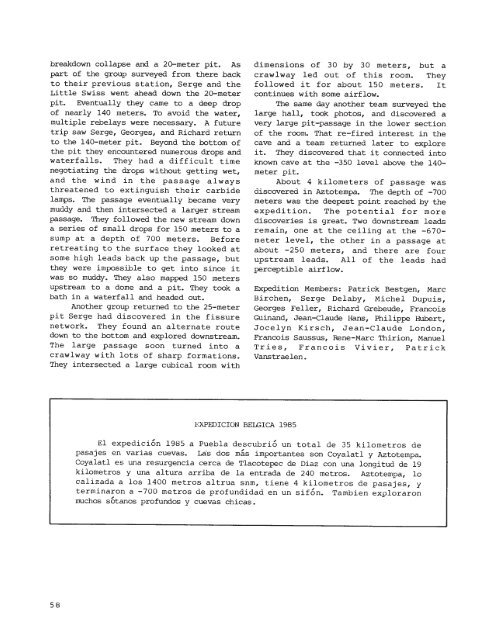8MB PDF - Association for Mexican Cave Studies
8MB PDF - Association for Mexican Cave Studies
8MB PDF - Association for Mexican Cave Studies
- No tags were found...
You also want an ePaper? Increase the reach of your titles
YUMPU automatically turns print PDFs into web optimized ePapers that Google loves.
eakdown collapse and a 2~meter pit. Aspart of the group surveyed from there backto their previous station, Serge and theLittle Swiss went ahead down the 20-meterpit. Eventually they came to a deep dropof nearly 140 meters. To avoid the water,multiple rebelays were necessary. A futuretrip saw Serge, Georges, and Richard returnto the 140-meter pit. Beyond the bottom ofthe pit they encountered numerous drops andwaterfalls. They had a difficult timenegotiating the drops without getting wet,and the wind in the passage alwaysthreatened to extinguish their carbidelamps. The passage eventually became verymuddy and then intersected a larger streampassage. They followed the new stream downa series of small drops <strong>for</strong> 150 meters to asump at a depth of 700 meters. Be<strong>for</strong>eretreating to the surface they looked atsome high leads back up the passage, butthey were iUlpossible to get into since itwas so muddy. They also mapped 150 metersupstream to a dome and a pit. They took abath in a waterfall and headed out.Another group returned to the 25-meterpit Serge had discovered in the fissurenetwork. They found an alternate routedown to the bottom and explored downstream.The large passage soon turned into acrawlway with lots of sharp <strong>for</strong>mations.They intersected a large cubical room withdimensions of 30 by 30 meters, but acrawlway led out of this room. Theyfollowed it <strong>for</strong> about 150 meters. Itcontinues with some airflow.The same day another team surveyed thelarge hall, took photos, and discovered avery large pit-passage in the lower sectionof the room. That re-fired interest in thecave and a team returned later to exploreit. They discovered that it connected intoknown cave at the -350 level above the 140meter pit.About 4 kilometers of passage wasdiscovered in Aztotempa. The depth of -700meters was the deepest point reached by theexpedition. The potential <strong>for</strong> morediscoveries is great. Two downstream leadsremain, one at the ceiling at the -670meter level, the other in a passage atabout -250 meters, and there are fourupstream leads. All of the leads hadperceptible airflow.Expedition Members: Patrick Bestgen, MarcBirchen, Serge Delaby, Michel Dupuis,Georges Feller, Richard Grebeude, FrancoisGUinand, Jean-elaude Hans, Philippe Hubert,Jocelyn Kirsch, Jean-Claude London,Francois Saussus, Rene-Marc Thirion, ManuelTries, Francois Vivier, PatrickVanstraelen.BXPEDICION BELGICA 1985El expedicion 1985 a Puebla descubrio un total de 35 kilometros depasajes en varias cuevas. La·s dos mas importantes son Coyalatl y Aztotempa.Coyalatl es una resurgencia cerca de Tlacotepec de Diaz con una longitud de 19kilometros y una altura arriba de la entrada de 240 metros. Aztotempa, 10calizada a los 1400 metros a1trua snm, tiene 4 kilometros de pasajes, yterminaron a -700 metros de profundidad en un sifon. Tambien exploraronmuchos sotanos profundos y cuevas chicas.58
















